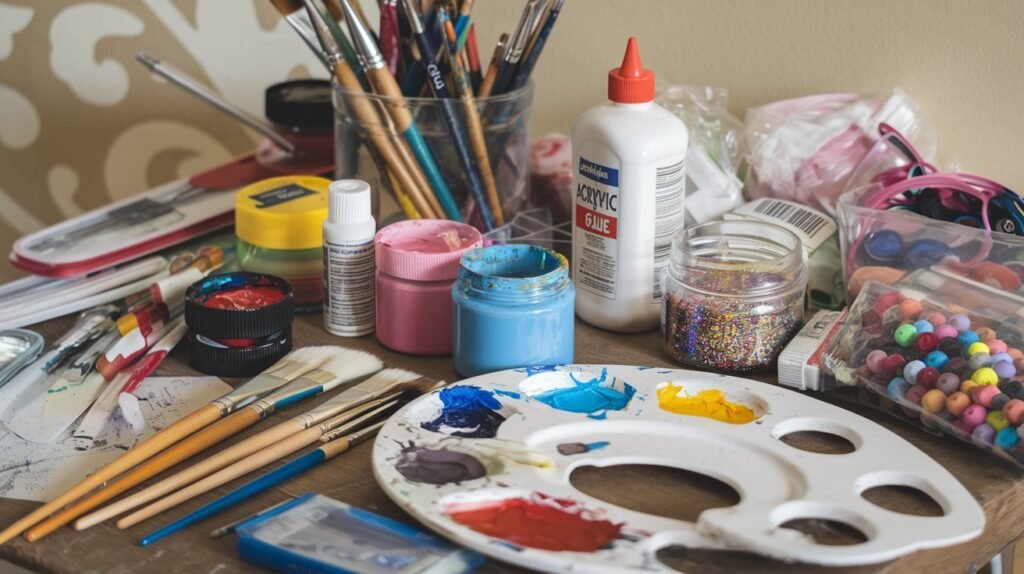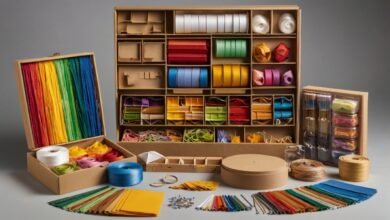
Top Arts and Crafts Supplies for Every Creative Project
Introductions:
Art and crafting have long been some of humanity’s most cherished forms of self-expression. They bring joy, relaxation, and the satisfaction of creating something beautiful with your hands. Whether you are a professional artist, a DIY crafter, or someone trying out creative hobbies, your journey begins with the right arts and crafts supplies.
In this ultimate guide, we will take an in-depth look at arts and crafts supplies, offering practical advice on how to choose the best materials, essential tools for different creative projects, and tips for caring for your supplies. With this resource, you’ll have all the information you need to unlock your full creative potential.
Why Art and Crafts Matter in Everyday Life
Art is not just a pastime; it’s a way to communicate emotions, tell stories, and enhance our living spaces. Crafting, on the other hand, taps into our resourcefulness, allowing us to make things by hand, which can provide a deep sense of fulfilment.
Creative activities like painting, knitting, sculpting, and paper crafting promote relaxation and mental well-being. Studies have shown that engaging in arts and crafts activities can reduce stress and anxiety, improve focus, and increase overall happiness. By investing in quality supplies, you create opportunities for these activities to enrich your life even more.
Choosing the Right Arts and Crafts Supplies: The Basics
Before diving into specific projects, it’s crucial to understand the wide variety of arts and crafts supplies available. Each medium comes with its own set of materials, and selecting the right tools can sometimes feel overwhelming. Here, we’ll break down some of the most common supplies and why they are essential for both beginners and seasoned creators.
Art Supplies: The Building Blocks of Creativity
1. Paints: The Heart of Every Painter’s Arsenal
Paint is one of the most versatile mediums in the world of art. Whether you’re painting landscapes, portraits, abstract pieces, or murals, the type of paint you choose will influence the outcome of your work.
- Acrylic Paints: Acrylics are water-based paints that dry quickly and are known for their vibrant colours. They are suitable for artists of all levels because they can be diluted with water for lighter washes or applied thickly for impasto effects. Acrylics adhere well to a variety of surfaces, including canvas, wood, and glass, making them a favourite for versatile projects.
- Oil Paints: Known for their rich texture and vibrant colours, oil paints offer a slow drying time, allowing artists to blend colours and add layers over several days. While oils are traditionally used for fine art paintings, they can be more challenging to work with for beginners due to their toxicity and the need for solvents.
- Watercolors: Watercolors are ideal for artists who love creating delicate, transparent effects. The beauty of watercolours lies in their ability to create soft transitions and layered depth, making them great for portraits, landscapes, and abstract work. A key aspect of working with watercolours is learning to control the amount of water to-pigment ratio, which can result in varying intensities of colour.
2. Drawing Materials: Pencils, Charcoals, and Pastels
Drawing serves as the foundation for many types of art, and it’s one of the easiest and most accessible forms of creative expression. Having the right drawing materials makes all the difference, especially when experimenting with textures and shadows.
- Graphite Pencils: A basic tool for any artist, graphite pencils come in a range of hardness levels, from soft (6B) to hard (9H). Soft pencils produce darker, richer lines, perfect for shading, while hard pencils are best for finer, lighter details.
- Charcoal: Charcoal provides rich, dark lines that are great for sketching and figure drawing. Its raw, expressive quality makes it perfect for dramatic contrasts, though it can be more difficult to control compared to pencils. Many artists prefer using charcoal to create life drawings or still lifes due to its flexibility in smudging and shading.
- Pastels: Available in both oil and soft varieties, pastels allow for bold, colourful drawing and blending. Oil pastels give a more textured finish, while soft pastels offer a chalk-like finish that can be easily blended for subtle shading.
3. Canvases and Paper: The Surfaces for Masterpieces
Your choice of surface can dramatically affect the outcome of your artwork. Choosing the right canvas or paper type ensures that your medium of choice adheres properly, holds up over time, and offers the best textural qualities for your style.
- Canvas: Stretched canvas is the go-to surface for acrylic and oil paintings. The material can come in a range of textures, from smooth to rough, depending on whether you’re creating fine details or bold strokes. Pre-primed canvases, which come ready to paint, are a convenient option for beginners, while raw canvas needs to be treated with gesso to prepare it for painting.
- Sketchpads and Watercolor Paper: Not all papers are created equal. Watercolour paper is thicker and designed to absorb water without warping. It comes in three main types: hot press (smooth), cold press (medium texture), and rough (highly textured). Meanwhile, sketchpads are ideal for pencil, charcoal, and pen work, offering smoother surfaces that allow for finer details.
Arts and Crafts Supplies: Tools for Every Creative Hobby
Crafting opens up a world of possibilities, from DIY home decor to personalized gifts. Here are some essential crafting tools that you’ll want in your arsenal.
1. Glue and Adhesives: The Unsung Heroes of Crafting
Whether you’re putting together a scrapbook or making a DIY photo frame, adhesives are essential for keeping everything in place.
- Hot Glue Guns: These are ideal for projects that involve wood, plastic, fabric, or metal. Hot glue sets quickly and provides a strong bond, but it’s best to use caution as it can burn skin.
- Mod Podge: This is a crafting essential, acting as both an adhesive and a sealant. It’s great for decoupage projects, allowing you to glue down paper or fabric and then coat it with a smooth, protective finish.
- Craft Glue: This is perfect for paper crafts or lightweight materials. There are many variations, from PVA glue to tacky glue, each serving different purposes in your crafting projects.
2. Scissors and Cutting Tools: Precision at Your Fingertips
When it comes to crafting, cutting is more than just snipping paper—precision is key. Having the right cutting tools ensures clean edges and professional-looking results.
- Craft Scissors: These are sharp and precise, designed for cutting detailed patterns in paper, fabric, or foam sheets.
- Rotary Cutters: Perfect for cutting straight lines on fabric, rotary cutters are a must-have for sewing and quilting projects.
- X-Acto Knives: Ideal for fine detail work, these precision knives can be used for cutting intricate shapes out of paper, cardboard, or thin wood.
3. Craft Papers and Embellishments: Adding Personality to Your Work
Craft paper comes in endless varieties, from thick cardstock to patterned scrapbook paper. It’s a key material for card-making, gift-wrapping, and paper art.
- Origami Paper: This lightweight, colourful paper is specifically designed for folding intricate shapes. Whether you’re making paper cranes or complex modular shapes, origami paper is a versatile addition to any craft stash.
- Glitter and Sequins: These are perfect for adding sparkle and flair to any project, whether it’s a hand-made greeting card or a DIY holiday ornament.
On Quality concerning Arts and Crafts Supplies.
While it’s tempting to save money by purchasing cheaper supplies, especially if you’re new to art and crafting, investing in higher-quality materials will pay off in the long run. Quality supplies not only last longer but also produce better results, which can make your creative process much more enjoyable.
Cheap brushes may shed bristles, low-quality paints may fade over time, and budget paper may warp or tear. By contrast, investing in quality supplies allows you to fully explore your creativity without the frustrations of tools that don’t work well.
How to Maintain and Care for Your Arts and Crafts Supplies
Your art and craft supplies are an investment, and taking care of them ensures they last as long as possible. Here are some tips for maintaining your supplies:
- Paintbrushes: Clean brushes immediately after use with the appropriate cleaning solution (water for water-based paints, solvents for oils). Store them upright with the bristles pointing up to prevent bending or fraying.
- Pencils and Charcoal: Keep your drawing tools sharp and store them in a dry place. Charcoal is particularly brittle, so it’s best kept in a case or wrapped in paper to prevent breakage.
- Paper and Canvas: Store paper flat to prevent it from bending or warping. Keep canvases in a cool, dry place, away from direct sunlight, which can cause discolouration over time.
Conclusion
Arts and crafts supplies are the foundation of any creative endeavour, whether you’re a beginner or an experienced artist. By choosing the right materials, caring for them properly, and considering their environmental impact, you can make the most of your creative projects while also being mindful of sustainability. Explore different types of supplies, experiment with various techniques, and let your imagination run wild. And if you’re equipped with the right tools, the only thing limiting you is your creativity.
FAQs About Arts and Crafts Supplies
What are the must-have art supplies for beginners?
For beginners, start with acrylic paints, a small set of brushes, sketch pencils, and a canvas or sketchpad. These materials will allow you to explore various techniques and styles without overwhelming you.
How do I find affordable craft supplies?
Many large retailers and online stores offer discounts, especially if you buy in bulk. Look for clearance sections, sign up for newsletters from craft stores, and take advantage of seasonal sales.
What types of glue are best for different materials?
For paper crafts, PVA glue or glue sticks should be used. Hot glue works well for heavier materials like wood, fabric, or plastic. For fabric projects, fabric glue provides a strong hold without damaging the material.
Can kids use regular art supplies?
Kids can use regular art supplies, but it’s important to make sure the materials are non-toxic and safe for use. Look for washable, child-friendly versions of paints, glues, and markers to ensure a safe crafting experience.
How do I store my craft supplies properly?
Store supplies in a cool, dry place to avoid damage from moisture or heat. Use bins or drawers to separate materials, and keep items like paints, brushes, and glues sealed when not in use to prevent them from drying out or deteriorating.
How can I reduce waste in my craft projects?
Reducing waste is easy with a few conscious decisions. Repurpose leftover materials, buy only what you need, and look for eco-friendly options. Donating unused materials to schools or community centres is another great way to reduce waste.








